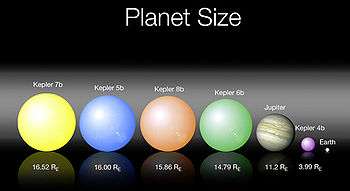Kepler-5
| Observation data Epoch J2000 Equinox J2000 | |
|---|---|
| Constellation | Cygnus |
| Right ascension | 19h 57m 37.7s |
| Declination | +44° 2′ 6.2″ |
| Apparent magnitude (V) | 13.9 |
| Details | |
| Mass | 1.347 M☉ |
| Radius | 1.793 R☉ |
| Luminosity | 0.669 L☉ |
| Temperature | 6297 K |
| Other designations | |
Kepler-5 is a star located in the constellation Cygnus in the field of view of the Kepler Mission, a NASA project aimed at detecting planets in transit of, or passing in front of, their host stars as seen from Earth. One closely orbiting, Jupiter-like planet, named Kepler-5b, has been detected around Kepler-5. Kepler-5's planet was one of the first five planets to be discovered by the Kepler spacecraft; its discovery was announced on January 4, 2010 at the 215th meeting of the American Astronomical Society after being verified by a variety of observatories. Kepler-5 is larger and more massive than the Sun, but has a similar metallicity, a major factor in planet formation.
Nomenclature and history
Kepler-5 is named so because it was the fifth planet-bearing star discovered during the course of the Kepler Mission, a NASA operation that seeks to discover Earth-like planets that transit, or cross in front of, their host stars with respect to Earth.[1] The star's planet, Kepler-5b, was the second of the first five planets to be discovered by the Kepler spacecraft; the first three planets found by Kepler were used as tests, and had already been discovered.[2] Kepler-5b was presented to the public on January 4, 2010 at the 215th meeting of the American Astronomical Society in Washington, D.C., along with planets around Kepler-4, Kepler-6, Kepler-7, and Kepler-8.[3]
Kepler-5b's initial discovery by Kepler was re-examined by scientists at the W.M. Keck Observatory at Mauna Kea, Hawaii; the McDonald Observatory in west Texas; the Palomar and Lick Observatories in California; the MMT, WIYN, and Whipple Observatories in Arizona; and the Roque de los Muchachos Observatory in the Canary Islands.[4]
Characteristics
Kepler-5 is a sunlike star that is 1.374 (± 0.056) Msun and 1.793 (± 0.053) Rsun, and is 137% the mass of and 179% the radius of the Sun. The star has a metallicity of [Fe/H] 0.04 (± 0.06), making it approximately as metal-rich as the Sun,[5] therefore increasing the star's likelihood to have planets in orbit.[6] Kepler-5 has an effective temperature of 6297 (± 60) K, which is hotter than the Sun's effective temperature of 5778 K.[7] Kepler-5 has an apparent magnitude of 13.4, and cannot be seen with the naked eye.[2]
Planetary system

Kepler-5b is 2.114 MJ and 1.431 RJ. It is, thus, more than twice the mass of Jupiter, and slightly less than three halves of Jupiter's radius. Kepler-5b orbits its star every 3.5485 days, lying at approximately .05064 AU from Kepler-5. It is, thus, a Hot Jupiter, or a gas giant that orbits near to its host star.[2] To compare, Mercury orbits the sun at .3871 AU every 87.97 days.[8] The planet's eccentricity is assumed to be 0, which is the eccentricity for a circular orbit.[2]
| Companion (in order from star) |
Mass | Semimajor axis (AU) |
Orbital period (days) |
Eccentricity | Inclination | Radius |
|---|---|---|---|---|---|---|
| b | 2.114 MJ | 0.05064 | 3.5485 | 0 | — | 1.431 RJ |
See also
References
- ↑ "Kepler: About the Mission". Kepler Mission. NASA. 2011. Retrieved 26 February 2011.
- 1 2 3 4 5 "Summary Table of Kepler Discoveries". NASA. 2010-08-27. Retrieved 2010-10-16.
- ↑ Rich Talcott (5 January 2010). "215th AAS meeting update: Kepler discoveries the talk of the town". Astronomy.com. Astronomy magazine. Retrieved 26 February 2011.
- ↑ "NASA's Kepler Space Telescope Discovers its FIrst Five Exoplanets". NASA. 4 January 2010. Retrieved 26 February 2011.
- ↑ "Notes for star Kepler-5". Extrasolar Planets Encyclopaedia. 2010. Retrieved 26 February 2011.
- ↑ Henry Bortman (12 October 2004). "Extrasolar Planets: A Matter of Metallicity". Space Daily. Retrieved 26 February 2011.
- ↑ David Williams (1 September 2004). "Sun Fact Sheet". Goddard Space Flight Center. NASA. Retrieved 26 February 2011.
- ↑ David Williams (17 November 2010). "Mercury Fact Sheet". Goddard Space Flight Center. NASA. Retrieved 26 February 2011.
Coordinates: ![]() 19h 57m 37.7s, +44° 2′ 6.2″
19h 57m 37.7s, +44° 2′ 6.2″